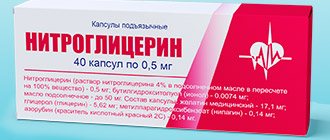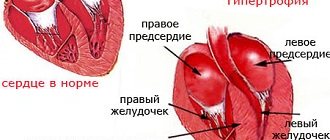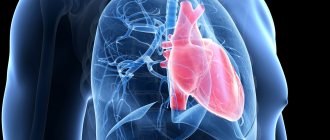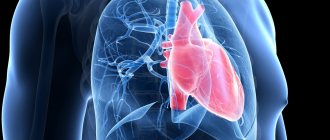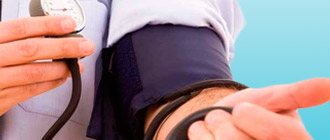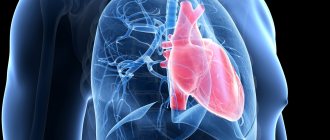Upper and lower blood pressure
The tonometer shows two numerical values, one of which is slightly higher than the other. For example, 110/70 or 120/80. These numbers, SYS (systole, first value) and DIA (diastole, second value), indicate the work of the heart muscle in different states.
Systolic (upper) pressure
-
pressure
on the walls of blood vessels during contraction of the heart muscle (systole).
A high upper
reading with a normal lower reading is considered a manifestation of heart disease.
Diastolic (bottom) pressure
-
pressure
on the walls of blood vessels during relaxation of the heart muscle (diastole).
A high
lower reading with a normal upper reading is a sign of atherosclerosis or kidney disease.
A mechanical tonometer is more accurate than an electronic one
A healthy person's blood pressure
decreases during sleep and increases with physical activity. Its norms gradually change with age. Adequate indicators in adolescence are 110/70, in adults - 120/80, in the elderly - no higher than 140/90.
Normal pressure readings
Blood pressure level is one of the key parameters of the human body - it is used to judge the state of health. Fluctuations in blood pressure (hereinafter referred to as “pressure”) in response to environmental influences show how ready the body is to adapt to changes.
It is important to take such fluctuations into account when measuring blood pressure, making a diagnosis and prescribing therapy.
Circadian rhythms
Our circadian rhythm consists of a sleep-wake cycle. This cycle is the most understandable example of circadian rhythms - cyclical changes in the body, tied to the change of day and night. Such an internal clock continues to tick even in the absence of information about the current time of day. They are embedded in the genome and limit the time of active activity of the body in order to give it the opportunity to recover [1].
One of the main elements in maintaining circadian rhythms is considered to be a small group of neurons in the brain located in the suprachiasmatic nucleus of the hypothalamus. This same part of the brain is responsible for the production of the hormone vasopressin, which has a pronounced effect on blood pressure levels. Thus, blood pressure levels are partly regulated by circadian rhythms. During sleep and 30-60 minutes after it, the pressure may be lower by 20-40 mmHg. Art., than typical for a person in a state of wakefulness [6].
Weather
A sharp change in atmospheric pressure can lead to the development of headaches and dizziness [6]. Adapting to the metamorphoses of the external environment, the body tries to balance external pressure with internal pressure. The tone of blood vessels changes, this leads to a sharp increase or decrease in pressure, which affects the level of oxygen in the tissues and sometimes manifests itself in the form of pain. Similar mechanics are observed in situations where the altitude above sea level changes - climbing mountains, flying, moving a long distance [7,8].
A sharp change in ambient temperature can also provoke a jump in blood pressure by 10-15 mmHg. Art. This applies to both a decrease and an increase in temperature, including its seasonal changes [6,7]. That is why it is not recommended to visit the bathhouse and sauna if you have arterial hypertension.
Most often, such rapid changes in external conditions occur when traveling long distances, for example, on vacation away from home. Such changes are perceived most painfully by weather-dependent people and patients with hypertension. Until recently, a trip meant a break from normal life, the inability to visit a doctor or measure blood pressure with a home blood pressure monitor. However, modern models are moving towards a reduction in size. A wrist tonometer can be a convenient option for such situations. It is lightweight, takes up little space, but is not inferior in accuracy to stationary instruments.
Physical activity
Running or strength training causes blood pressure to rise during exercise. Usually its height is 20-30 mm Hg. Art., but when lifting significant weights or doing weightlifting, a rise of up to 40-50 mm Hg is recorded. Art. [3, 5]. The pressure remains elevated for another hour after exercise, and then decreases to normal levels. At the same time, a decrease in pressure several hours after exercise to a level slightly lower than usual is also the norm.
In professional athletes, pressure changes occur by smaller amounts and more smoothly. Amateur athletes or people with chronic diseases may experience sudden changes in pressure [3, 10].
Monitoring blood pressure levels during sports or heavy physical labor is especially important in the presence of chronic diseases of the cardiovascular system [5, 9]. Since sports often take place outside the home, this is another category of people to whom a compact wrist tonometer can be recommended.
Stress and psycho-emotional factors
Strong emotions (both negative and positive) cause activation of the sympatho-adrenal axis, a long chain from the brain to the adrenal glands, which leads to the release of hormones, such as adrenaline, into the blood [1]. Adrenaline makes the heart beat faster and blood vessels constrict. In such situations, blood pressure rises. This is one of the reasons why people with heart problems are advised to avoid strong emotional experiences.
An important factor in the development of hypertension is chronic stress. In urban environments, it is provoked by increased noise, an abundance of artificial light, and professional burnout syndrome [1, 2, 4]. Research shows that men, in general, cope worse with these factors—just 5 years of work associated with negative emotions is enough to develop hypertension [2, 10]. Women are also confirmed to be influenced by an unfavorable environment, however, for the development of hypertension, the duration and strength of the factors must be greater than in the case of men.
Other external factors
In addition to the factors described above, WHO and specialized associations for the study of hypertension note the following most common causes of increased blood pressure:
- errors in diet (excessive consumption of table salt and caffeine) [5, 9, 10, 11],
- poor environmental conditions (high levels of lead, cadmium, mercury) [6],
- the use of certain medications, the action or side effects of which may increase blood pressure (for example, steroids, adaptogens, etc.) [5, 8]
- smoking [9, 10, 11].
If a person experiences high blood pressure 2 or more times a week, this is one of the signs of a high risk of developing hypertension [5]. That is why therapists recommend keeping a health diary and recording observations of your condition there in order to see a doctor in time. In such a diary it is worth entering information about sleep patterns, periods of emotional decline, heart rate and blood pressure levels. A tonometer with a function for storing measurements can help you track the dynamics of changes and help you fill out your health diary.
1. Pickering TG (1997). The effects of environmental and lifestyle factors on blood pressure and the intermediary role of the sympathetic nervous system. Journal of human hypertension, 11 Suppl 1, S9–S18. 2. Ohlin, B., Berglund, G., Rosvall, M., & Nilsson, P. M. (2007). Job strain in men, but not in women, predicts a significant rise in blood pressure after 6.5 years of follow-up. Journal of hypertension, 25(3), 525–531. https://doi.org/10.1097/HJH.0b013e32801220fa 3. Currie, K. D., Floras, J. S., La Gerche, A. et al. Exercise Blood Pressure Guidelines: Time to Re-evaluate What is Normal and Exaggerated?. Sports Med 48, 1763–1771 (2018). https://doi.org/10.1007/s40279-018-0900-x 4. Pickering, T. G., Devereux, R. B., James, G. D., Gerin, W., Landsbergis, P., Schnall, P. L., & Schwartz, J. E. ( 1996). Environmental influences on blood pressure and the role of job strain. Journal of hypertension. Supplement: official journal of the International Society of Hypertension, 14(5), S179–S185. 5. Campbell, N. R., Burgess, E., Choi, B. C., Taylor, G., Wilson, E., Cléroux, J., Fodor, J. G., Leiter, L. A., & Spence, D. (1999). Lifestyle modifications to prevent and control hypertension. 1. Methods and an overview of the Canadian recommendations. Canadian Hypertension Society, Canadian Coalition for High Blood Pressure Prevention and Control, Laboratory Center for Disease Control at Health Canada, Heart and Stroke Foundation of Canada. CMAJ : Canadian Medical Association journal = journal de l'Association medicale canadienne, 160(9 Suppl), S1–S6. 6. Brook, R. D., Weder, A. B., & Rajagopalan, S. (2011). "Environmental hypertension" the effects of environmental factors on blood pressure in clinical practice and research. Journal of clinical hypertension (Greenwich, Conn.), 13(11), 836–842. https://doi.org/10.1111/j.1751-7176.2011.00543.x 7. Modesti P. A. (2013). Season, temperature and blood pressure: a complex interaction. European journal of internal medicine, 24(7), 604–607. https://doi.org/10.1016/j.ejim.2013.08.002 8. Strapazzon, G., & Semplicini, A. (2009). Should travelers with hypertension adjust their medications when traveling to high altitude?. High altitude medicine & biology, 10(3), 305–306. https://doi.org/10.1089/ham.2009.1021 9. Touyz, R. M., Campbell, N., Logan, A., Gledhill, N., Petrella, R., Padwal, R., & Canadian Hypertension Education Program ( 2004). The 2004 Canadian recommendations for the management of hypertension: Part III—Lifestyle modifications to prevent and control hypertension. The Canadian journal of cardiology, 20(1), 55–59. 10. Samadian, F., Dalili, N., & Jamalian, A. (2016). Lifestyle Modifications to Prevent and Control Hypertension. Iranian journal of kidney diseases, 10(5), 237–263. 11. Ozemek, C., Laddu, D. R., Arena, R., & Lavie, C. J. (2018). The role of diet for prevention and management of hypertension. Current opinion in cardiology, 33(4), 388–393. https://doi.org/10.1097/HCO.0000000000000532
Author: Kasabov K.A.,
Lecturer at the First Moscow State Medical University named after I.M. Sechenov, researcher at the Research Institute of Pharmacology named after. V.V. Zakusova.
Share this article with your friends
Symptoms of High Blood Pressure
If you feel unwell and don’t have a blood pressure monitor at hand, pay attention to the symptoms
.
They may indicate problems with blood pressure.
Signs of high blood pressure
- Dizziness.
- Weakness.
- Heart pain.
- Headache.
- Numbness of arms and legs.
- Nausea.
- Noise in ears.
- Heart rhythm disturbances.
- Facial redness.
- Swelling.
If you measure your blood pressure and it turns out to be high, it is recommended to repeat the measurement at least within a week. Do this at the same time and record the indicators. If the pressure constantly exceeds the age norm by 15 units or more (for example, does not fall below 135/85 when the norm is 120/80), this is a reason to consult a doctor. Regardless of age, do not allow readings of 140/90 or higher.
If measures are not taken in time, there is a risk of hypertensive crisis - a critical increase in blood pressure that threatens life.
Blood pressure and factors influencing it
A healthy person's blood pressure should be within normal limits, but many people suffer from hypertension (high blood pressure) or hypotension (low blood pressure). Blood pressure (BP) is the pressure of blood in the large arteries of a person. Blood pressure is distinguished: maximum (systolic, or upper), minimum (diastolic, or lower), pulse pressure. Blood pressure is measured in millimeters of mercury (mmHg)
The ideal pressure is considered to be 120/80 mmHg. Art. The difference between the upper and lower pressure should normally be about 30–40 mmHg. Art.
Most healthy people have blood pressure within these figures. But deviations from the ideal value are also allowed.
Upper pressure should be no less than 100 and no more than 139 mmHg. Art. [1, p. 17]
Blood pressure was first measured by Stefan Holes (England) in the 18th century. The mercury manometer was invented by J. Poiseuille (France) in 1828. This method requires puncturing an artery and is sometimes used in animal experiments these days. At the end of the 19th century, the Italian scientist Riva-Rocci proposed measuring blood pressure using a cuff that compresses the limb. Pressure was judged by the disappearance or appearance of a pulse in the arteries. The existing method is based on the invention of N. S. Korotkov, which was made in 1905. It allows you to determine the upper and lower pressure limits.
Among many health problems, a person faces problems related to blood pressure. Increased blood pressure leads to diseases such as cerebral hemorrhage or heart disease. Deviation of blood pressure from the norm leads to numerous diseases and complications. The higher the blood pressure level, the higher the risk of developing dangerous diseases such as coronary heart disease, stroke, heart attack, and kidney failure. [3, p. 9]
The author of the article conducted research related to blood pressure using the
PROLOG
digital biology laboratory , which allows the necessary measurements to be carried out with great accuracy using special sensors and a computer.
Study 1 “Measuring blood pressure in 8th grade students and determining its compliance with the norm.” The study involved 11 people aged 13–15 years. To determine the normal blood pressure in adolescents, there is a certain formula: upper pressure: 1.7 * age + 83, lower pressure: 1.6 * age + 42. At 13 years old, blood pressure is considered normal: 105/63. At 14–15 years old, normal blood pressure is 110/65. The person being examined must be in a lying or sitting position. Air must be pumped into and out of the cuff quickly enough. During the manipulation, a calm, benevolent atmosphere should be created:
Table 1
Results of measuring blood pressure in 8th grade students
| Subject No. | Age | HELL | Normal blood pressure for a given age | Deviations from the norm |
| 1 | 14 | 107/73 | 110/65 | |
| 2 | 13 | 115/91 | 105/63 | + |
| 3 | 14 | 117/90 | 110/65 | + |
| 4 | 15 | 108/64 | 110/65 | |
| 5 | 14 | 122/95 | 110/65 | + |
| 6 | 15 | 139/78 | 110/65 | + |
| 7 | 14 | 104/77 | 110/65 | |
| 8 | 14 | 118/96 | 110/65 | + |
| 9 | 14 | 101/71 | 110/65 | |
| 10 | 14 | 119/84 | 110/65 | + |
| 11 | 14 | 123/95 | 110/65 | + |
The study showed that 7 out of 11 students (64%) had blood pressure levels above normal. It was found that they often experience headaches and weakness. These symptoms interfere with their studies. We recommended that these students measure their blood pressure daily and consult a doctor if necessary.
Study No. 2 “Dependence of blood pressure on age.” The study involved 5 people aged 13–15 years, 5 people aged 20–40 years, 5 people aged 40–60 years.
table 2
Results of measuring blood pressure in people of different ages
| Subject No. | Age | HELL |
| 1 | 14 | 107/73 |
| 2 | 13 | 115/91 |
| 3 | 14 | 117/90 |
| 4 | 15 | 108/64 |
| 5 | 14 | 122/95 |
| 6 | 25 | 125/75 |
| 7 | 27 | 130/80 |
| 8 | 30 | 127/78 |
| 9 | 39 | 110/70 |
| 10 | 40 | 135/80 |
| 11 | 50 | 145/85 |
| 12 | 54 | 130/73 |
| 13 | 55 | 135/85 |
| 14 | 57 | 142/87 |
| 15 | 60 | 143/88 |
There are certain guidelines for the dependence of blood pressure on age:
| Age | 16–20 years old | 20–40 years | 40–60 years | Over 60 years old |
| Upper pressure | 100–120 | 120–130 | Up to 140 | 150 |
| Lower pressure | 70–80 | 70–80 | Up to 90 | 90 |
As a result of the study, we can conclude that with age, a person’s blood pressure increases. For example, if a teenager's blood pressure is 135/85, this will be a deviation from the norm, but for older people this blood pressure is normal.
Study No. 3 “The effect of physical activity on blood pressure.” The study involved 11 people aged 13–14 years. First, we measured the blood pressure of each participant in the experiment in a calm state (results of study No. 1), and then after physical activity (25 squats) and compared the results.
Table 3
Blood pressure readings at rest and after exercise
| Subject No. | Age | BP at rest | BP after exercise |
| 1 | 14 | 107/73(92) | 120/90(98) |
| 2 | 13 | 115/91(84) | 112/97(89) |
| 3 | 14 | 117/90(98) | 134/98(99) |
| 4 | 14 | 108/64(90) | 125/97(101) |
| 5 | 14 | 122/95(96) | 130/88(93) |
| 6 | 15 | 139/78(98) | 145/75(98) |
| 7 | 14 | 104/77(73) | 129/71(96) |
| 8 | 15 | 118/96(87) | 120/82(89) |
| 9 | 14 | 101/71(79) | 117/79(93) |
| 10 | 14 | 119/84(93) | 119/89(90) |
| 11 | 14 | 123/95(97) | 135/80 (99) |
In all participants in the experiment, blood pressure, as well as pulse (indicated in parentheses), increased slightly after physical activity. This is explained by the fact that when performing physical exercises, the heart rate increases, as the need for oxygen throughout the body increases. Along with the acceleration of the heart, blood pressure increases proportionally.
Blood pressure indicators are influenced by many factors, for example, age, physical activity, atmospheric pressure, alcohol, nicotine, stress, excess weight, etc. According to the results of the studies, it can be concluded that some students have blood pressure indicators that exceed the norm. This negatively affects their health and studies. It should be remembered that in some cases we can protect ourselves from problems associated with blood pressure disorders, and, consequently, from concomitant diseases. For example, a person decides for himself whether he should drink alcohol, smoke, or not smoke. You should think about your health at an early age so as not to suffer later.
Literature:
1. Barsukov A.V. Arterial hypotension. Current issues of diagnosis, prevention and treatment. SPb.: ELBI, 2012.
2. Kopylova O. S. 120/80. How to beat hypertension. M.: Eksmo, 2013.
3. Malysheva I. S. Hypertension, ischemia, heart attack. Effective treatment and prevention. M.: Vector, 2013.
When is increased blood pressure considered normal?
High blood pressure is not necessarily a sign of illness. Its short-term increase is also possible for physiological reasons
:
- 1
Childhood and adolescence. In children, the cardiovascular system develops more slowly than the musculoskeletal system, and in adolescence the body experiences hormonal changes. It is accompanied by changes in mood for no apparent reason, which leads to jumps blood pressure.At rest, a teenager’s indicators may be higher than during physical activity.
- 2
Physical exercise. Running, lifting weights and other types of physical activity increase the oxygen demand of the involved muscle groups. This need, due to increased frequency and strengthening of heart contractions, is ensured by intense blood flow. Due to the accelerated work of the cardiovascular system, an increase in pressureduring and after physical activity.
- 3
Stress. Situations in which a person experiences anger or fear lead to the release of adrenaline into the blood. The result is tachycardia and high blood pressure.
Normal pressure
increases briefly.
This is not a cause
for concern, but a reason to monitor to rule out the development
of hypertension
.
Arterial hypertension in children and adolescents with endocrine pathology
Part 1
Arterial hypertension (AH) is one of the types of cardiovascular pathology that significantly affects morbidity and mortality. There are primary (essential) and secondary (symptomatic) arterial hypertension. Essential hypertension is a heterogeneous disease with progressive damage to organs and systems with different development mechanisms at the initial stages. It is of primary importance among middle-aged and elderly people. Secondary hypertension, which includes endocrine hypertension, accounts for 15% of cases in the population. Moreover, in children they occur much more often than in adults, and at primary school age, secondary hypertension predominates [1]. This article discusses one of the common types of secondary arterial hypertension - hypertension caused by endocrine diseases.
Physiological mechanisms of blood pressure regulation
Blood pressure is created due to the fact that the heart throws blood into the vessels, overcoming great resistance to its movement. Vascular tone is determined mainly by the state of their smooth muscles.
In arterial vessels, blood pressure fluctuates significantly depending on the phase of the cardiac cycle - systole, diastole. Systolic blood pressure (SBP) is formed due to the energy of ventricular systole during the period of expulsion of blood from them. Diastolic blood pressure (DBP) is determined by the elasticity of the walls of arterial vessels.
In a healthy body, maintaining a normal blood pressure level is carried out by a multicomponent system, which is represented by neurogenic, humoral and local factors. They act in inextricable connection with each other and are complementary.
The control of pressor and depressor reactions is associated with the activity of the bulbar vasomotor center. It is controlled by hypothalamic structures and the cerebral cortex and is realized through changes in the activity of sympathetic and parasympathetic nerves.
The activity of the autonomic nervous system is influenced by both genetic factors and environmental factors (stress, physical activity, body weight). Increased activity of the sympathetic nervous system (SNS) leads to increased contractile activity of the myocardium and increased tone of vascular smooth muscles. The hypertensive effect of the sympathetic nervous system is also realized through the suppression of the synthesis of nitric oxide (NO), which has a vasodilating effect. In addition to its direct influence, the hypothalamus coordinates vascular tone through the endocrine system (neurohypophysis and adenohypophysis).
Rapid regulation of blood pressure is carried out by the release of adrenaline and norepinephrine from the adrenal medulla. Both hormones have different effects on blood pressure. Adrenaline increases blood pressure mainly due to increased heart function, minute volume, and pulse rate. Norepinephrine produced in neurons has a direct effect on vascular tone. The pressor effect of adrenaline is much stronger. By directly acting on adrenergic receptors, which cause vasoconstriction, norepinephrine increases both systolic and diastolic blood pressure [2].
The renin-angiotensin-aldosterone system (RAAS) forms the foundation of modern ideas about the regulation of blood pressure.
Renin is a proteolytic enzyme synthesized in the juxtaglomerular apparatus of the kidneys. It is one of the renal pressor factors. Its effect on vascular tone is mediated through angiotensin. Once in the blood, renin converts angiotensinogen into angiotensin I. The release of renin is controlled by three main mechanisms: baroreceptors in the walls of the afferent renal artery, which are stimulated when perfusion pressure decreases; receptors of the heart and large arteries, which activate the sympathetic nervous system, leading to an increase in the level of catecholamines in the blood and direct stimulation of the juxtaglomerular apparatus (via β-adrenergic receptors); the content of sodium ions in the distal tubules of the nephrons. Renin release inhibitors include angiotensin II, thromboxane, endothelin, NO, and atrial natriuretic peptide (ANP).
Angiotensinogen is a peptide synthesized in the liver. Glucocorticoids, estrogens, insulin, and thyroid hormones increase the production of this protein. With a decrease in sodium content in the body, accompanied by an increase in renin levels, the rate of angiotensinogen metabolism increases sharply. The mechanism of increased hepatic production of angiotensinogen is unclear, although angiotensin II is known to stimulate the production of the former.
Angiotensinogen, which does not have pressor activity, is hydrolyzed to form angiotensin I, a biologically inactive substance. Under the action of angiotensin-converting enzyme (ACE), angiotensin I is converted to angiotensin II, which is a highly active endogenous pressor factor. ACE also inhibits bradykinin, i.e. it itself is a key element in the regulation of blood pressure.
Angiotensin II is the main hormone in the RAAS chain, causing a rapid increase in blood pressure and total peripheral vascular resistance (TPVR). It stimulates the synthesis and secretion of aldosterone in the adrenal glands and the secretion of antidiuretic hormone, excites the sympathetic system (by facilitating the secretion of norepinephrine by nerve endings and increasing the sensitivity of smooth muscle fibers to this transmitter). Under the influence of angiotensin II, the secretion of adrenaline increases and cardiac output increases.
A similar renin-angiotensin-aldosterone system was found in various organs and tissues (heart, kidneys, brain, blood vessels). It has been shown that the activity of tissue RAAS depends largely not on ACE, but on other enzymes (chymases, cathepsin G, etc.). Increased activity of tissue RAAS causes long-term effects of angiotensin II, which are manifested by structural and functional changes in target organs.
The physiological effects of angiotensin II are realized through specific angiotensin receptors. There are two classes of angiotensin II receptors - AT1 and AT2. The cardiovascular, renal, and adrenal effects of angiotensin II are realized through AT1 receptors.
Acting directly on the adrenal cortex, angiotensin II stimulates the secretion of aldosterone, as well as its precursors - less active mineralocorticoids - deoxycorticosterone, 18-hydroxycortisone, 18-hydroxydeoxycorticosterone. The main stimulator of aldosterone production is renin. Its secretion is partly dependent on adrenocorticotropic hormone (ACTH).
Aldosterone plays a key role in regulating sodium and potassium balance. The synthesis and secretion of aldosterone is regulated in two ways. The slow mechanism depends on the K+/Na+ balance and maintains basal secretion. An increase in serum potassium levels stimulates the synthesis of aldosterone in the zona glomerulosa of the adrenal cortex. The fast regulatory pathway depends on circulating blood volume (CBV) and is controlled by the renin-angiotensin system. Aldosterone exerts its specific effect through the mineralocorticoid receptor, which is located in epithelial cells (distal parts of the nephron and other organs) that transport sodium. The direct effect of aldosterone is carried out by increasing the entry of sodium into the cell and activating the Na+/K+ pump, not only in the renal tubules, but also in the intestines, sweat and salivary glands. Aldosterone is also involved in the processes of vascular remodeling and myocardial fibrosis.
Vasopressin is an antidiuretic hormone (ADH) of the hypothalamus, accumulates in the posterior lobe of the pituitary gland and is then secreted into the blood. Vasopressin increases blood volume, increases vascular tone, increasing peripheral resistance. The development of hypertension is facilitated by an increase in the sensitivity of the vascular wall to the constrictor effect of catecholamines, under the influence of ADH.
Estrogens and glucocorticoids increase serum aldosterone concentrations indirectly through an increase in the production of angiotensinogen in the liver and an increase in the formation of angiotensin II. The pressor effect of glucocorticoids is also achieved by increasing the sensitivity of the vascular wall to the effects of catecholamines.
So, hormones are directly involved in the regulation of vascular tone. With pathology of the endocrine organs, this can form severe and persistent hypertension.
The feedback mechanism is provided by the function of baroreceptors, which are located in the aortic arch, sinocarotid zone and renal arteries. With an increase in blood pressure through these reflexogenic zones, the depressor effect on the vasomotor center increases, which leads to inhibition of sympathetic and increased parasympathetic activity with a decrease in the formation of hypertensive factors. This reduces heart rate and force and peripheral resistance.
A powerful vasodilator that lowers blood pressure is atrial natriuretic peptide, which is synthesized by atrial cardiomyocytes. It is actively released during atrial stretching caused by hypervolemia, stimulation of β-adrenergic receptors, exposure to angiotensin II, endothelin and hypernatremia. This peptide increases sodium excretion by the kidneys, suppresses the RAAS, SNS, and vasoconstrictor factors of the vascular endothelium.
The endothelin system corrects the basic regulation of blood pressure. Endothelins are peptides synthesized in endothelial cells that cause vasoconstriction by acting on type A endothelin receptors. A smaller part of endothelin, interacting with type B endothelin receptors, stimulates the synthesis of nitric oxide (NO) and causes vasodilation. NO synthesis also increases under the influence of moderate physical activity, angiotensin II, vasopressin, and catecholamines.
Other endothelial factors that significantly influence vasodilation are kinins. Representatives of this group are bradykinin and kallidin. Kinins have a vasodilatory effect by activating prostaglandins and nitric oxide; have natriuretic and diuretic effects. These vasoactive factors of the vascular endothelium are realized through their effect on vascular smooth muscle [3].
The development of hypertension in some endocrine diseases is based on the excessive production and secretion of hormones that have a direct or indirect effect on vasospasm. Timely diagnosis of endocrine pathology allows you to correctly interpret the cause of increased blood pressure and exclude essential hypertension.
Hypothyroidism and thyrotoxicosis
Thyroid hormones have a direct effect on cardiac function and vascular tone. Arterial hypertension occurs in both hypothyroidism and thyrotoxicosis.
In hypothyroidism, DBP mainly increases. This is due to bradycardia, weakening of myocardial contractility. The speed of blood flow decreases and the volume of circulating blood decreases. The secretion of natriuretic hormone is disrupted, which causes sodium and water retention in the body. The secretion of renin and aldosterone does not change. The sensitivity of vascular receptors to circulating catecholamines increases. Vascular resistance is increased by more than 50%, diastolic filling time is increased. Hyperlipidemia (64%) contributes to the development of hypertension, accelerating the formation of the atherosclerotic process. In this case, it is similar to essential hypertension.
Increased blood pressure is a common symptom of thyrotoxicosis. The pathogenesis of hypertension in thyrotoxicosis is associated with an increase in cardiac output, an increase in cardiac output, activation of the kallikrein-kinin system, hypersecretion of adrenomedullin, and functional hypercortisolism.
Thyroid hormones directly bind to cardiomyocytes, exerting a positive inotropic effect. They increase the sensitivity and expression of adrenergic receptors and, as a result, increase sensitivity to catecholamines. The heart rate increases and blood flow accelerates. Systolic pressure increases. Hypertension in thyrotoxicosis is called high-output syndrome, but there is no left ventricular hypertrophy. The latter is explained by a decrease in diastolic blood pressure.
Skin vessels dilate compensatoryly (reaction to release heat). They feel warm and moist to the touch. General and peripheral resistance are reduced. It has been shown that in thyrotoxicosis the kinin-kallikrein system is activated. In recent years, the participation of adrenomedullin in reducing DBP in patients with thyrotoxicosis has been proven. The peptide adrenomedullin has very pronounced vasodilator activity.
An increase in systolic blood pressure and a tendency towards a decrease in diastolic blood pressure is accompanied by an increase in pulse blood pressure. Patients may feel a pulsation in the head with each systole. The pulse is characterized by a rapid rise and sudden decline of the pulse wave (pulsus celer et altus). In addition, thyrotoxicosis is accompanied by an increase in blood volume and erythrocyte mass. A persistent increase in blood pressure is detected in patients with a history of the disease of more than 3 years. Patients with thyrotoxicosis develop hypertension much more often than the general population [4, 5, 7].
Hyperparathyroidism
Hypertension in hyperparathyroidism is caused by the effect of an excess amount of ionized calcium on vascular tone. To contract vascular smooth muscle cells, calcium ions are required, which enter the cytoplasm of the cells and interact with the protein calmodulin. The resulting complex (calcium + calmodulin) activates myosin light chain kinase, resulting in contraction of smooth muscle fibers. Calcium in high concentrations can excessively enhance cellular metabolic processes. Transmembrane transport of calcium ions occurs through special calcium channels. Since the concentration of calcium ions in the blood is closely related to the contractility of smooth muscles, hypercalcemia leads to increased resistance to blood flow in the peripheral arteries. On the other hand, excess calcium, irritating the sympathetic nervous system, indirectly stimulates the release of catecholamines. Experimental data have shown that the calcium-induced increase in peripheral vascular resistance is sharply reduced after adrenalectomy. Long-term excess calcium can lead to calcification of blood vessels and increased blood pressure [6, 7].
Diabetes
Diabetes mellitus (DM) is recognized as a worldwide non-infectious pathology. The increase in life expectancy of patients with diabetes has brought to the fore the problem of late vascular complications. Diabetes mellitus and arterial hypertension are two interrelated pathologies that have a powerful mutually reinforcing damaging effect aimed at several target organs at once: the heart, brain vessels, and retina.
The mechanisms of development of hypertension in type 1 and type 2 diabetes differ. In type 1 diabetes, hypertension in 90% of cases is formed as a result of diabetic nephropathy (DN). Microalbuminuria (early stage of DN) is detected in patients with type 1 diabetes with a disease duration of less than 5 years, and increased blood pressure usually develops 10–15 years after the onset of type 1 diabetes.
Hyperglycemia is the main cause of damage to the microvasculature, including glomerular vessels. Chronic hyperglycemia activates the processes of non-enzymatic protein glycosylation, the polyol pathway of glucose metabolism and direct glucose toxicity.
Since vascular endothelial cells are insulin-independent, glucose freely penetrates into the cells, causing their dysfunction. Non-enzymatic glycosylation of proteins, the conversion of glucose into sorbitol with the participation of the enzyme aldoreductase, the long-term and uncontrolled effect of glucose on the structure of cells in type 1 diabetes, associated with the activation of the enzyme protein kinase C, leads to an increase in the permeability of vascular walls and cell proliferation, accelerating the processes of tissue sclerosis, disruption of intraorgan hemodynamics [8].
Hyperlipidemia, which develops in type 1 diabetes, also contributes to the development of diabetic nephropathy. In type 1 diabetes, atherogenic low-density lipoprotein (LDL) and very low-density lipoprotein (VLDL) cholesterol and triglycerides accumulate in the blood. Hyperlipidemia causes damage to the endothelium, glomerular basement membrane, and mesangial proliferation.
The formation of hypertension in type 1 diabetes is based on a sustained increase in intraglomerular pressure, which many authors associate with impaired tone of glomerular arterioles as a result of endothelial dysfunction. The effectiveness of NO decreases due to a decrease in its formation and an increase in its destruction, a decrease in the density of muscarinic-like receptors, the activation of which leads to the synthesis of NO, an increase in ACE activity on the surface of endothelial cells, which catalyzes the conversion of angiotensin I to angiotensin II, as well as the production of endothelin I and other vasoconstrictor substances . An increase in the formation of angiotensin II leads to spasm of effector arterioles and an increase in the ratio of the diameter of the afferent and efferent arterioles.
Angiotensin II plays a key role in the development of hypertension and renal failure. It has been established that the local renal concentration of angiotensin II is 1000 times higher than its content in plasma. The mechanisms of the pathogenic action of angiotensin II are due not only to its powerful vasoconstrictor effect, but also to proliferative, prooxidant and prothrombin activity. At the same time, angiotensin II has a damaging effect on other tissues in which its activity is high (heart, vascular endothelium), maintaining high blood pressure.
Prevention and treatment of hypertension in patients with type 1 diabetes consists of achieving optimal compensation of carbohydrate metabolism and correction of intrarenal hemodynamics. For this purpose, ACE inhibitors are used. These drugs are recommended to be prescribed at the stage of microalbuminuria (captopril, enalapril, ramipril, etc.) [9].
Metabolic syndrome
Metabolic syndrome (MS) unites a group of different diseases closely associated with type 2 diabetes. MetS is based on insulin resistance (IR) and hyperinsulinemia (HI). The most frequently combined components of MS are abdominal obesity, arterial hypertension and atherogenic dyslipidemia (increased triglyceride levels and decreased high-density lipoprotein cholesterol (HDL). According to some data, metabolic syndrome is detected in adolescents with up to 50% obesity.
Unlike subcutaneous fat, which makes up 75% of the body's total adipose tissue and is the main storage of lipids, abdominal fat is currently considered an independent endocrine organ. Its adipocytes synthesize a significant amount of various biologically active substances involved in the metabolism of glucose, fats, inflammation, coagulation, eating behavior, and regulation of vascular tone.
Abdominal obesity associated with MS is a key mechanism in the formation of hypertension. It turned out that adipose tissue ranks second after the liver in the formation of angiotensinogen. In obesity, adipocytes have increased renin content, ACE activity, significantly increased angiotensin II content, and increased expression of angiotensin II type 1 receptors (AT1 receptors). The activity of the tissue renin-angiotensin system is closely related to the production of adipokines by adipose tissue.
Impaired lipid metabolism leads to excessive fat deposition in tissues and decreased activity of enzymes involved in glucose metabolism. In the vascular endothelium, a protein kinase is activated, which inhibits the synthesis of nitric oxide.
On the other hand, IR leads to the development of compensatory hyperinsulinemia, which can maintain normal carbohydrate metabolism for a long time. The relationship between GI and hypertension is so strong that if a patient has a high concentration of plasma insulin, it is possible to predict the development of hypertension in the near future.
At high concentrations, insulin increases the activity of the sympathoadrenal system, the reabsorption of sodium and water in the proximal tubules of the kidneys, increases the proliferation of vascular smooth muscle cells, blocks the activity of Na+/K+-ATPase and Ca2+/Mg2+-ATPase, increasing the intracellular content of Na+ and Ca2+, which increases the sensitivity of blood vessels to the effects of vasoconstrictors.
Increased activity of the sympathetic nervous system with excess fat mass leads to an increase in cardiac output and heart rate, increased sodium reabsorption, and, in general, an increase in intravascular blood volume.
The reason for the development of IR is not clear. It is assumed that the development of peripheral IR is based on hyperactivity of the renin-angiotensin system. Angiotensin II in high concentrations competes with insulin at the level of insulin receptors (IRS 1 and 2), thereby preventing its action at the cellular level. On the other hand, the existing IR and GI activates the AT1 receptors of angiotensin II, leading to the implementation of the mechanisms for the development of hypertension.
So, in MS, the main role in the development of hypertension, cardiovascular complications and the progression of atherosclerosis is played by the high activity of the renin-angiotensin system. The treatment of MS is based on reducing body weight (see treatment of obesity) and increasing the sensitivity of receptors to insulin. For this purpose, biguanides are recommended (metformin (Siofor, Glucophage, etc.)), which inhibit the absorption of glucose in the intestine, inhibit the rate of its formation in the liver, and increase the number of glucose transporters in target cells [10].
Obesity
Hypertension is closely associated with overweight and obesity. In adolescents, this combination occurs in 30% of cases. The main reason for the increasing prevalence of obesity and its complications is the energy imbalance between excess energy intake in the form of foods and its expenditure as a result of reduced physical activity.
Primary obesity (constitutional-exogenous) is an independent neuroendocrine disease, depending on the disruption of the adipose-hypothalamic relationship. In this form, there is relative or absolute leptin deficiency on an alimentary-hypodynamic background.
The most common form of secondary obesity in adolescents is hypothalamic syndrome of puberty (pubertal-adolescent dyspituitarism). The essence of the disease is caused by dysregulation of hormones (liberins) by the hypothalamus, mainly by increased secretion of corticoliberin during puberty. At the clinic, patients complain of headaches, thirst, fatigue, and excess body weight. More common in females. Obesity with uniform distribution of fat. The skin has stretch marks of different colors. In girls, the menstrual cycle is often disrupted. The boys' faces are effeminate and their hair is sparse. Gynecomastia and stretch marks are often detected.
Hypertension in these forms of the disease is associated with hemodynamic changes: an increase in circulating blood volume, stroke and cardiac output with “inadequately normal” peripheral resistance. In the secondary form, it is aggravated by hyperproduction of ACTH and cortisol. Clinically, hypertension can manifest itself as a moderate increase in blood pressure; in some it increases to hypertensive crises.
The effect of treating obesity, metabolic syndrome and associated hypertension depends on the patient's motivation to change lifestyle, which involves increased physical activity and a reduced-calorie diet. Physical exercise has a positive effect on the emotional and psychological health of the individual. Physical activity promotes the consumption of large amounts of carbohydrates, the release of neutral fats from the depot, their breakdown and transformation. It must correspond to the age and individual characteristics of patients, providing increased energy consumption. These are morning exercises, walks, swimming, dancing, skiing and cycling, massage, etc. Physical activity should be of medium intensity, promoting increased consumption of carbohydrates and fats. It is recommended to limit the intake of salt, animal fats, and quickly digestible carbohydrates in food. To correct hypothalamic-pituitary disorders, drugs are prescribed that improve trophism and microcirculation (Cavinton, Nootropil, etc.). Of the antihypertensive drugs in this group of patients, it is preferable to use ACE inhibitors, since they have an organoprotective effect, as well as diuretics in small doses [9].
Read the end of the article in the next issue.
V. V. Smirnov1, Doctor of Medical Sciences, Professor M. D. Utev A. I. Morozkina
GBOU VPO RNIMU im. N. I. Pirogova Ministry of Health of the Russian Federation, Moscow
1 Contact information
